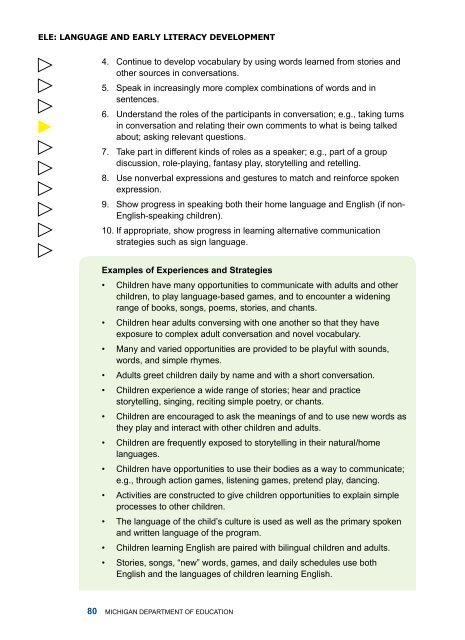Early Childhood Standards of Quality for ... - State of Michigan
Early Childhood Standards of Quality for ... - State of Michigan
Early Childhood Standards of Quality for ... - State of Michigan
Create successful ePaper yourself
Turn your PDF publications into a flip-book with our unique Google optimized e-Paper software.
ELE: Language and <strong>Early</strong> Literacy Development4. Continue to develop vocabulary by using words learned from stories andother sources in conversations.5. Speak in increasingly more complex combinations <strong>of</strong> words and insentences.6. Understand the roles <strong>of</strong> the participants in conversation; e.g., taking turnsin conversation and relating their own comments to what is being talkedabout; asking relevant questions.7. Take part in different kinds <strong>of</strong> roles as a speaker; e.g., part <strong>of</strong> a groupdiscussion, role-playing, fantasy play, storytelling and retelling.8. Use nonverbal expressions and gestures to match and rein<strong>for</strong>ce spokenexpression.9. Show progress in speaking both their home language and English (if non-English-speaking children).10. If appropriate, show progress in learning alternative communicationstrategies such as sign language.Examples <strong>of</strong> Experiences and Strategies• Children have many opportunities to communicate with adults and otherchildren, to play language-based games, and to encounter a wideningrange <strong>of</strong> books, songs, poems, stories, and chants.• Children hear adults conversing with one another so that they haveexposure to complex adult conversation and novel vocabulary.• Many and varied opportunities are provided to be playful with sounds,words, and simple rhymes.• Adults greet children daily by name and with a short conversation.• Children experience a wide range <strong>of</strong> stories; hear and practicestorytelling, singing, reciting simple poetry, or chants.• Children are encouraged to ask the meanings <strong>of</strong> and to use new words asthey play and interact with other children and adults.• Children are frequently exposed to storytelling in their natural/homelanguages.• Children have opportunities to use their bodies as a way to communicate;e.g., through action games, listening games, pretend play, dancing.• Activities are constructed to give children opportunities to explain simpleprocesses to other children.• The language <strong>of</strong> the child’s culture is used as well as the primary spokenand written language <strong>of</strong> the program.• Children learning English are paired with bilingual children and adults.• Stories, songs, “new” words, games, and daily schedules use bothEnglish and the languages <strong>of</strong> children learning English.80 <strong>Michigan</strong> Department <strong>of</strong> Education


